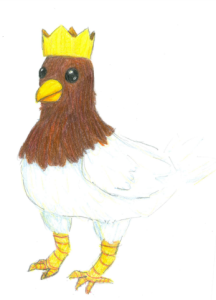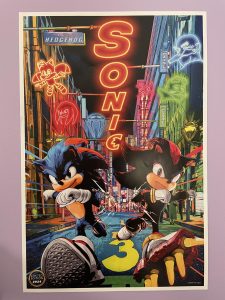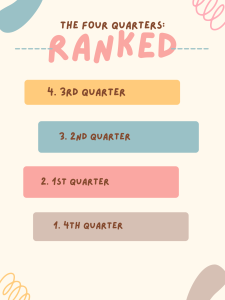“Donda” Breaks Barriers, Provokes Audiences

West walks the stage at a listening party. Image-Hollywood Reporter
October 5, 2021
The views expressed in this article belong to the reporter, and do not reflect the views held by Rockbridge County High School, the Prowler Staff, and its members.
Kanye West’s newest long play record, “Donda,” has proven to be the 44 year old creative’s most innovative, and talked about album. West drew massive attention with a string of listening parties held in Mercedes-Benz Arena, including a dramatic ascension sequence where West was lifted into the sky as the album concluded, and bizarre, ritualistic performances involving an exact replica of his childhood home. The rapper’s prolonging of the album’s release only served to stir up more and more excitement as a series of promised release dates each came and went with no album to speak of. Then, on Aug. 29, 2021, the record finally appeared on streaming services, and sparked one major question. What was Kanye thinking?
Given its unprecedented 108 minute forty-nine second run time, curious introduction, and some seemingly unfinished cuts, confusion is not unwarranted. While most longtime fans were quick to praise the album, “Donda’s” more casual audience gave a much more muddled response. The album’s sound is instantly unique and recognizable given West’s signature production style, and clear lines could be drawn from his previous release, “Jesus Is King,” to this new offering. The gospel-infused hip-hop of “Jesus Is King” is still prominent on “Donda,” but the grittier, darker production lent itself to a more ominous atmosphere, and this is no surprise. In the past year, West has gone through a public divorce, and has repeatedly attested to how this had put him in a dark place. This gloominess is reflected in the dreamy, completive “Moon” and the heavier, more crushing “Jail.”
The lyrical content of the album ranges from religious to despondent, and still has a healthy dose of West’s ‘braggadocio.’ Much of the album is inspired, if not directly dedicated to West’s mother, whom it also derives its name from. Donda West’s voice is included on several tracks, including a long excerpt of her praising her son’s uniqueness and expressing her support for him. In fact, many of Donda’s appearances on “Donda” serve to promote her son, and the conflation of these snippets with religious imagery, especially surrounding Jesus, led some fans to believe Kanye to be displaying himself as some quasi-messianic figure. Regardless of the true meaning behind it, West’s constant assertion of himself as a renaissance man and an object of fascination creates an air of importance throughout the album, and adds greatly to the spectacle of the music. Extensive spoken word sections on tracks like “Believe What I Say” maintain a sense of religiosity throughout the music, which is bolstered by interspersed organ instrumentation and choir-like group vocals.
From a production standpoint, “Donda” is almost avante-garde, and certainly pushes the boundaries of rap production and engineering. West features plenty of traditional instrumentation like electric guitar and bass, which is not uncommon for modern hip-hop, but the use of effects on these tracks make them feel digitized or even artificial. This digital feel is prominent in the album as Kanye and his team combine hard-hitting beats with distorted and oft-manipulated synth and bass lines. Compared to his earlier releases, “Donda” may be West’s most abrasive album, and is unafraid to experiment with EDM-esque electronic manipulation or intense vocal manipulation as found on “Remote Control” as well as several other tracks. However, this gritty, loose sound crosses the line into discord or dirtiness at times, or at others just feels incomplete. Speculation surrounding the release of the album led some fans to theorize that West was forced to release an incomplete record, which given his penchant for indulgently composed tracks could explain some of the sparse orchestration on “Donda.” Another theory regarding the unfinished sound of some tracks, most notably “Jail,” which includes an isolated section of drums following a percussion-free song, posits that West may be inviting listeners to ‘finish’ the album as they see fit. By releasing stem players, West opened the door for fans to manipulate the instrumentals on “Donda” using a handheld device, and many lyrics on the album allude to his days spent churning out beat after beat as an aspiring producer. This theory also points to the religious themes of the album as evidence West could be presenting “Donda” almost as a divine teaching, inviting listeners to practice the same skills he honed before his big break.
For me, “Donda’s” beauty does not lie in its weirdness or possible underlying messages, but in its massively provocative nature. Regardless of critical reception or even general understanding of the album, it instantly became massively successful and hotly debated, but also opened up more intellectual discussions about the current state of hip-hop. Concept album or not, “Donda” is certainly inspired and framed around certain ideas and themes, and West uses a plethora of production techniques and unique sounds to paint a sonic picture as well as a lyrical one. “Donda” is not, in my eyes, a commercial album. This is obvious simply from the massive amount of delays and redactions that West imposed before eventually releasing the record. He worked to fulfill his concept, not the expectations of fans, and in doing so created a precedent for what a massively popular hip-hop album could be. “Donda” proves to the music community that popular rap audiences are ready for, and receptive to, painstakingly created, indulgent, and boundary breaking musical works. Just as Miles Davis’ “Bitches Brew” deconstructed notions of what jazz could be, as well as angering and confusing many fans, “Donda” has this same potential to reshape the sound of a genre, but only time-and new releases will tell.







